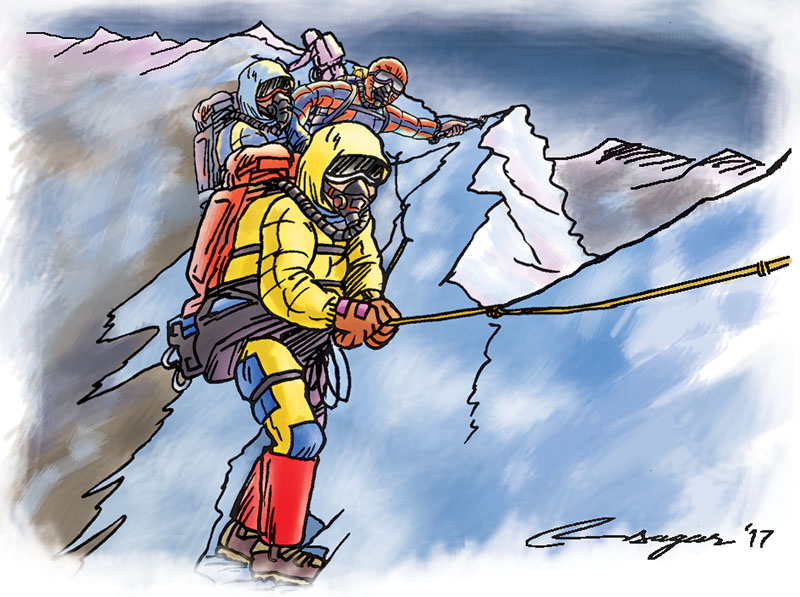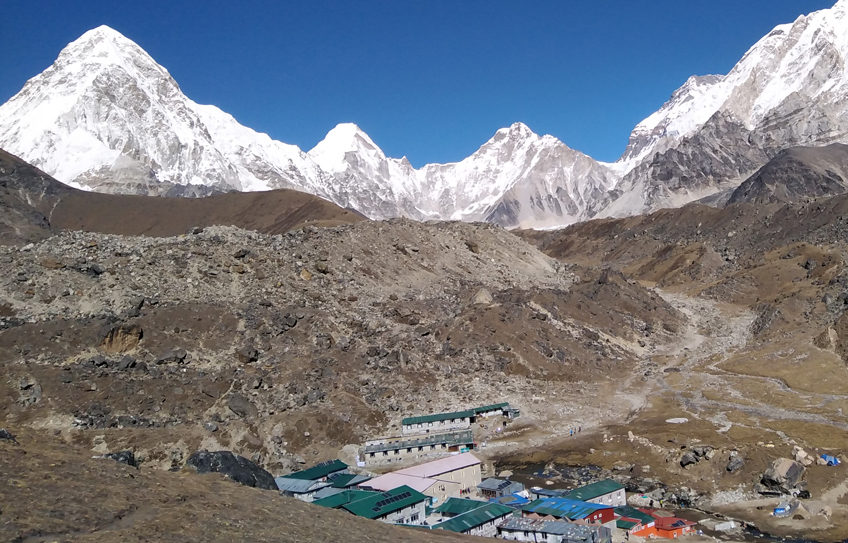Key features and attractions of Lobuche Peak prepared by Trekking Planner Nepal.
Lobuche Peak is renowned for its challenging ascent and stunning natural beauty. Situated in the Khumbu Region, it offers breathtaking panoramic views of the surrounding Himalayan giants, including Everest, Lhotse, Nuptse, and Ama Dablam, making it a key destination for peak climbing in Nepal. The pristine alpine environment, with its snow-capped mountains and icy glaciers, creates a surreal setting that captivates the senses.
In addition to the awe-inspiring scenery, Lobuche Peak also holds historical significance. It was a key vantage point during Sir Edmund Hillary and Tenzing Norgay's historic ascent of Everest in 1953. As you conquer Lobuche Peak, you'll follow in mountaineering legends' footsteps and immerse yourself in the rich Himalayan mountaineering history.
Permits and Logistics that the Government sets up for Climbing Lobuche Peak.
Before beginning your Lobuche Peak adventure, it's essential to obtain the necessary permits and familiarize yourself with the logistics involved. To climb Lobuche Peak, you'll need a climbing permit issued by the Nepal Mountaineering Association (NMA). It's advisable to hire the services of a reputable trekking agency, as they will handle the permit application process, arrange transportation, and provide experienced guides.
As part of the permit process, you'll also need to secure a Sagarmatha National Park entry permit, as the peak lies within its boundaries. It's crucial to plan your expedition during the peak climbing seasons of spring (April–May) and autumn (September–November) to ensure favorable weather conditions and maximize your chances of a successful summit.
Physical and Mental Preparation is Required for Climbing Lobuche Peak.
Climbing Lobuche Peak demands a high level of physical fitness and mental preparation. The ascent involves long hours of trekking, steep inclines, and challenging technical sections. Therefore, it's crucial to embark on a comprehensive training regimen well in advance. Focus on building your cardiovascular endurance through activities such as hiking, running, and cycling.
Incorporate strength-training exercises to strengthen your core, legs, and upper body. Additionally, altitude acclimatization is vital, as Lobuche Peak reaches heights above 6,000 meters. Gradual ascent, proper hydration, and regular rest days during the trek will help your body acclimatize effectively. Mental preparation is equally important, as the climb can be mentally exhausting. Practice meditation, visualization, and mental resilience techniques to enhance your mental fortitude.

Essential Gear and Equipment are Suggested for Climbing Lobuche Peak.
Having the right gear and equipment is crucial for a successful and safe climb of Lobuche Peak. Invest in high-quality mountaineering boots that provide excellent insulation and traction. Layered clothing is essential, including base layers, insulating layers, and a waterproof shell. Don't forget to pack a warm down jacket, gloves, a hat, and sunglasses to protect yourself from the harsh mountain elements.
Other necessary gear includes a climbing harness, crampons, an ice axe, a helmet, and a backpack. It's essential to have a reliable sleeping bag and a lightweight tent for overnight stays at high camps. Don't forget to pack essential items such as sunscreen, a headlamp, a first aid kit, and plenty of high-energy snacks to keep you fueled during the climb.
Climbing Routes and Techniques for Climbing Lobuche Peak.
Lobuche Peak offers multiple climbing routes, each with its own challenges and rewards. The most popular route is the East Peak, which offers a moderate technical challenge suitable for climbers with prior mountaineering experience. The West Peak, on the other hand, presents a more challenging and technical ascent, requiring advanced climbing skills. It's crucial to assess your climbing abilities and choose a route that aligns with your skills and experience level.
The climbing techniques required for Lobuche Peak include ice climbing, glacier travel, and rock climbing. Familiarize yourself with these techniques and consider enrolling in a mountaineering course to refine your skills before attempting the climb. Rope handling, crevasse rescue, and proper use of climbing equipment are vital skills to ensure your safety on the mountain.
Safety Measures and Precautions are Recommended for Climbing Lobuche Peak.
Safety should be a top priority when climbing Lobuche Peak. It's essential to be aware of the risks associated with high-altitude mountaineering and take the necessary precautions to minimize them. Acclimatization is key to preventing altitude sickness, so follow a slow and steady ascent, allowing your body to adjust to the thin air. Stay hydrated and consume a balanced diet to maintain your energy levels.
It's advisable to climb with an experienced guide who can assess the weather conditions, monitor your health, and provide guidance throughout the ascent. Familiarize yourself with the signs and symptoms of altitude sickness and be prepared to descend if necessary. Always adhere to safety protocols, such as roped travel on glaciers and securing yourself with appropriate climbing equipment.

Accommodation Options that are Available During the Lobuche Peak Expedition.
During your Lobuche Peak expedition, you'll have several accommodation options to choose from. The most common choice is teahouse lodges, which are basic but comfortable guesthouses along the trekking route. These lodges provide simple rooms, communal dining areas, and basic amenities such as hot showers and Wi-Fi. Another option is camping, where you can set up your tents at designated campsites along the route.
This option offers a more immersive experience in nature but requires carrying additional camping gear. Some expeditions also offer the option of staying in high-altitude climbing huts, which provide a warm and sheltered environment closer to the summit. Regardless of your chosen accommodation option, it's essential to carry a warm sleeping bag and expect basic facilities at higher altitudes.
Trekking Planner Nepal arranges all the accommodation facilities for Lobuche Peak climbing.
Recommended itineraries for climbing Lobuche Peak.
To maximize your chances of summiting Lobuche Peak and ensure a safe and enjoyable climb, it's crucial to follow a well-planned itinerary. The standard itinerary for climbing Lobuche Peak typically spans around 18 days, including acclimatization days and rest days. It involves trekking from Lukla to Namche Bazaar, Tengboche, Dingboche, and Lobuche Base Camp before attempting the summit.
Outline Itinerary from Trekking Planner Nepal.
- Day 1: Arrival in Kathmandu (1,350 m) and transfer to the hotel.
- Day 2: A full day in Kathmandu with a half-day sightseeing tour.
- Day 3:Fly to Lukla (2,830 m) and trek to Phakding (2,640 m) in 4 hours.
- Day 4:Trek to Namche Bazaar (3,440 m) in 6 hours.
- Day 5:Rest day at Namche Bazaar for acclimatization and local excursion.
- Day 6:Trek to Tengboche Monastery (3,867 m), 05 hrs.
- Day 7:Trek to Dingboche, 4,260 m, 5 hrs.
- Day 8:Rest day at Dingboche for acclimatization and excursion.
- Day 9:Trek to Lobuche, 4,930 m, 5 hrs.
- Day 10:Trek to Gorakshep (5,170 m) and Everest Base Camp (5,364 m) and return to Gorakshep (6 hrs).
- Day 11:Hike to Kalapatthar (5,545 m) and trek to Lobuche Base Camp (4,865 m).
- Day 12:Climb to Lobuche High Camp (5,600 m/18,368 ft) in 4 hours.
- Day 13:Climb the summit at 6,119m (20,070 ft) and Trek to Thukla at 09 hrs.
- Day 14:Trek to Namche Bazaar, 7-hour walks.
- Day 15:Trek to Lukla (06 hrs.).
- Day 16:Fly to Kathmandu and transfer to the hotel.
- Day 17: In Kathmandu with a sightseeing tour.
- Day 18: International departure for homeward bound.
For more information, click this link for detailed information.
Tips for a Successful and Enjoyable Climbing Experience on Lobuche Peak.
As you embark on your Lobuche Peak Adventure, keep in mind the following tips to enhance your climbing experience:
- Start your training and preparation well in advance to build the necessary fitness and stamina.
- Invest in high-quality gear and equipment and ensure you are familiar with their use.
- Follow a slow and steady ascent to acclimatize effectively and minimize the risk of altitude sickness.
- Stay hydrated and maintain a balanced diet to keep your energy levels up.
- Listen to your body and communicate openly with your guide about any symptoms or concerns.
- Embrace the journey and enjoy the breathtaking beauty of the Khumbu region.
- Respect the local culture and environment, and leave no trace behind.
- Celebrate your achievements and savor the sense of accomplishment as you stand on the summit of Lobuche Peak.
Conclusion from Trekking Planner Nepal.
Conquering Lobuche Peak is a challenging but immensely rewarding experience. With proper preparation, training, and guidance, you can overcome the physical and mental obstacles and reach the summit of this majestic peak. The allure of the Khumbu Region, coupled with the thrill of mountaineering, creates a truly unforgettable adventure.
So, gather your gear, lace up your boots, and embark on a journey that will test your limits and leave you with lifelong memories. As you conquer Lobuche Peak, immerse yourself in the beauty of the Himalayas, stand in awe of the towering peaks, and revel in the sense of accomplishment that comes with conquering new heights.
Explore our Peak Climbing in Nepal Packages
Island Peak Climbing
Lobuche and Island Peak Climbing
Mera Peak Climbing
Pokalde Peak Climbing
Yala Peak Climbing


.webp)





